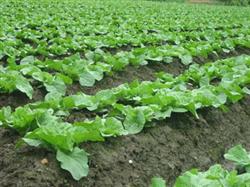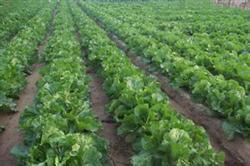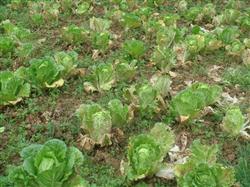Key points of fertilization techniques for autumn sowing Chinese cabbage

The goal of fertilization for Chinese cabbage is to achieve the dual goal of both high yield and high quality. According to the nutritional characteristics of Chinese cabbage, its demand ratio of nitrogen, phosphorus and potassium is 1 ∶ 0.5 ∶ 1.2, indicating that its demand for potassium is also greater than that of nitrogen. However, the actual production of Chinese cabbage generally only pays attention to the fertilization of nitrogen fertilizer, and often neglects the balanced supplement of potassium fertilizer. Based on the fertilization status of Chinese cabbage in recent years, it is necessary to grasp three principles. At present, the main problems in applying appropriate amount of nitrogen fertilizer to Chinese cabbage are: the phenomenon of blind partial application of nitrogen fertilizer is serious, and the one-time application amount of nitrogen fertilizer is too large, which leads to the loss of nitrogen fertilizer and the obstruction of calcium absorption. The principle of fertilization should be based on soil fertility conditions, optimize the amount of nitrogen, phosphorus and potassium fertilizer, give priority to base fertilizer, and combine base fertilizer with topdressing fertilizer. Topdressing is mainly nitrogen, reasonable coordination of nitrogen, phosphorus and potassium, and appropriate supplement of trace elements. It is planned to produce 3 500-4500 kg of fresh vegetables per mu, including 2000 kg of organic fertilizer, 20 kg of pure nitrogen, 6 kg of phosphorus (P2O5) and 14 kg of potassium (K2O). The yield per mu is 4500m 6000 kg, the application of organic fertilizer is 3000 kg, pure nitrogen is 23 kg, phosphorus (P2O5) 5 is 8 kg, potassium (K2O) 16 is 202 kg, organic fertilizer and phosphorus, 30% potash fertilizer are used as base fertilizer, 70% nitrogen and potash fertilizer are applied separately before rosette stage and Baoxin stage. For the high quality and high yield of Chinese cabbage, how much nitrogen fertilizer should be applied? Production practice has proved that for every 1000 kg of fresh vegetables, it is necessary to absorb about 2.0kg of pure nitrogen from the soil, and 10kg of pure nitrogen is needed to produce 5000 kg of fresh vegetables, which can come from soil organic fertilizer and chemical fertilizer respectively. Under the condition of applying a large amount of organic fertilizer, the amount of chemical nitrogen fertilizer should be reduced. The application of appropriate amount of nitrogen fertilizer has a good effect on the growth and development of Chinese cabbage, which is beneficial to photosynthesis, which is the key to achieve high quality and high yield of Chinese cabbage. In some remote areas, there may be insufficient supply of nitrogen fertilizer, thin leaves and light color, rough and hard tissue, which not only affects the yield, but also the quality is not good. However, at present, the actual amount of nitrogen applied in most Chinese cabbage production far exceeds the demand, and excessive application of nitrogen fertilizer not only thickens the outer leaves of Chinese cabbage, has poor core, low yield and quality, but also has high leaf water content, is not resistant to storage and storage after harvest, and is easy to rot. Easy to suffer from diseases and insect pests in the late growth stage. Therefore, in addition to the appropriate amount of nitrogen fertilizer, the period of nitrogen application is also very important. In the whole growth period of Chinese cabbage, the amount of nitrogen uptake was also different at different stages. The seedling stage is very little, accounting for about 2% of the total, the rosette stage increases to about 28% of the nitrogen, and the nitrogen uptake in the pericardium stage is the most, accounting for about 70% of the total. Therefore, the application of nitrogen fertilizer should be applied in stages, reflecting the light in the front and the weight in the back. It is necessary to increase the fertilization ratio of phosphorus and potassium and increase potassium fertilizer in base fertilizer and topdressing fertilizer, which is beneficial to the enveloping and disease resistance of Chinese cabbage. Attention should be paid to the application of potash fertilizer in the dressing period. If the supply of phosphorus and potassium in Chinese cabbage is insufficient, it will not bear balls. At present, the application of potash fertilizer is often ignored in vegetable production. The suitable amount of potassium application is generally 16 kg of potassium sulfate per mu. The best application method is divided into base fertilizer and topdressing: base fertilizer is applied at the bottom of the hole when planting, and topdressing is carried out after squatting seedlings at the end of rosette stage, combined with nitrogen fertilizer and irrigation. Ensuring the supply of calcium supplements the nutrition of calcium through the application of calcium superphosphate, which is very beneficial to prevent the occurrence of "dry heartburn" in Chinese cabbage. Chinese cabbage is a calcium-loving crop, calcium deficiency, especially excessive nitrogen application is easy to cause "burning heart disease". Controlling nitrogen fertilizer and supplementing calcium nutrition are the core technologies to prevent "dry heartburn" disease of Chinese cabbage. The method of calcium supplement, in addition to the bottom application of calcium fertilizer, can also adopt the method of foliar spraying. 0.3% of 0.5% calcium chloride or calcium nitrate is sprayed every 10 murals for 15 days, and the control effect can reach more than 95%.
- Prev

Early preparation for disease prevention of autumn Chinese cabbage
As the saying goes: head-volt radish, two-volt mustard, stand autumn plant cabbage. Now it is time to plant autumn Chinese cabbage again. We should plant autumn Chinese cabbage in time to ensure high quality and high yield. Now the key points of cultivation techniques of autumn Chinese cabbage are introduced as follows: select varieties with good fertilizer and water conditions, select tall, late and medium-maturing varieties; fertilizer.
- Next

Which fungicides can control root rot of Chinese cabbage
The cause of downy mildew of Chinese cabbage is fungal disease, which is mainly caused by leaves, and stems and flowers can also be damaged. After being infected, the front of the leaf produces watery chlorotic spots, and then develops into yellowish brown, which is polygonal due to the limitation of leaf veins due to the enlargement of the disease spot. When the weather is wet, there is a white sparse mildew layer on the back of the leaves.
Related
- Where is it suitable to grow horseradish in China? it is expected to see the middle altitude horseradish in Alishan.
- How to prevent tomato virus disease reasonably? (Control methods included)
- Many people like to plant towel gourd on the balcony. What are the main points of this method and management?
- What crops can chili peppers be mixed with?
- Fertilization techniques and matters needing attention in Tomato
- What are the grafting techniques for peach seedlings in spring?
- Harm and control methods of root swelling disease of Chinese cabbage
- What are the pests of sweet potatoes? How to prevent and cure it?
- Symptoms, causes and Control methods of navel Rot in Tomato
- The cause of "Cucumber rotten bibcock" in Farmers' planting Cucumber and its Control Plan

